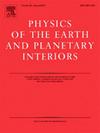Midcrustal moderate-size earthquake occurrence in paleovolcanic structures off Jeju Island, South Korea
Abstract
A series of midcrustal moderate-size earthquakes occurred in the Korean Peninsula recently. A midcrustal strike-slip earthquake with a fault-plane strike in N-S occurred on December 14, 2021 at the southwestern offshore region of Jeju Island, South Korea. The fault plane orientation and slip sense (faulting mechanism) hardly conform with the regional stress field. The deep focal depth and N-S directional strike-slip motion require transient changes in the medium properties and stress field. Strong ground motions of the midcrustal earthquake induce preferential dynamic stress changes in NE-SW direction, triggering subsequent aftershocks in NE-SW-directional adjacent faults. Both the static and dynamic stress changes caused by the mainshock contribute to the aftershock sequence. The number and focal depths of aftershocks decrease with distance from the mainshock. The different fault-plane orientations between the mainshock and aftershocks suggest earthquake nucleations in independent fault structures. The mainshock occurred in aseismic midcrustal paleovolcanic structure on the outskirt of a high seismicity region. The earthquake suggests possible nucleation of earthquake in seismically-inactive paleotectonic structures, successively incurring aftershocks conforming to the ambient stress. The mainshock and aftershocks suggest that paleotectonic structures may behave as source structures to spawn earthquakes.

 求助内容:
求助内容: 应助结果提醒方式:
应助结果提醒方式:


